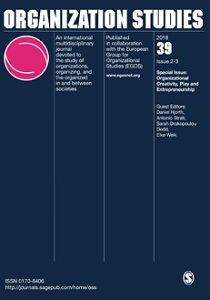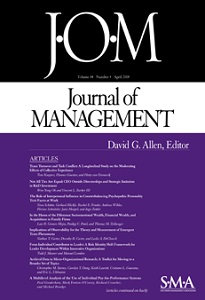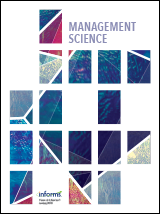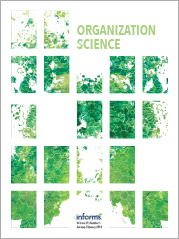Academic articles
Practitioner articles
Working papers
Books
Book chapters
Case studies
Other publications
Subject(s)
Human resources management/organizational behavior; Strategy and general management
Keyword(s)
Congress, ideology, influence, social capital, status
Prior research assumes that high-status actors have greater organizational influence than lower-status ones, that is, it is easier for the former to get their ideas and initiatives adopted by the organization than it is for the latter. Drawing from the literature on ideology, we posit that the status–influence link is contingent on actors’ ideological position. Specifically, status confers organizational influence to the degree that the focal actor is ideologically mainstream. The more an actor’s ideology deviates from the mainstream the less will her status translate into increased organizational influence. We find support for this hypothesis using data on the work of legislators in the House of Representatives in the United States Congress. By illuminating how and under what conditions status leads to increased influence, this study qualifies and extends current understandings of the role of status in organizations.
With permission of SAGE Publishing
Volume
43
Journal Pages
35–57
Subject(s)
Human resources management/organizational behavior
Keyword(s)
impasses, negotiations, agreements, conflict resolution, bargaining
Although impasses are frequently experienced by negotiators, are featured in newspaper articles, and are reflected in online searches, and can be costly, negotiation scholarship does not appear to consider them seriously as phenomenon worth explaining. A review of negotiation tasks to study impasses reveals that they bias negotiators towards agreement. We systematically organize past findings on impasses and integrate them in the impasse type, cause, and resolution model (ITCR model). Our fundamental assumption is that a positive bargaining zone does not imply symmetric preferences for an agreement. One or both negotiators may prefer an impasse over an agreement despite a positive bargaining zone. We argue that it is beneficial for management research to distinguish between three impasse types: if both negotiators perceive benefit from an impasse, they are wanted; if one negotiator perceives benefits from an impasse, they are forced; and if both do not perceive benefits from the impasse, they are unwanted. We review structural (e.g., bargaining zone, communication channels), interpersonal (e.g., tough tactics, emotions) and intrapersonal (e.g., biases, available information, and framing) factors as the likely antecedents of the three impasse types. We also examine evidence which suggests that wanted impasses can be resolved by changing the negotiation structure for both parties, forced impasses can be resolved through persuasion, and unwanted impasses can be overcome by debiasing both parties. Finally, we review current methodological guidance and provide updated recommendations on how scholars should deal with impasses in both study designs and data analyses.
With permission of SAGE Publishing
Volume
48
Journal Pages
49–76
Subject(s)
Information technology and systems
Keyword(s)
Sovereignty, cyberspace, cyber operations, Tallinn Manual, cyber sovereignty, digital sovereignty, defend forward, persistent engagement
The article critically examines the current discourse on the legal status and substance of “sovereignty” in the context of the application of international law to cyberspace against the backdrop of conflicting political-ideological attitudes. After tracing the origins of the interpretation of “respect for sovereignty” as a primary rule of international law, two approaches to cyberspace are surveyed that challenge the emerging consensus: “cyber imperialism,” embodied by the US and the other Five Eyes members on the one hand, and “cyber Westphalia,” represented by China, Russia, and Iran on the other. Both conceive cyberspace in ways fundamentally irreconcilable with prevailing legal views. A third group of states endorses the “sovereignty-as-rule” understanding but leaves this legal position vulnerable to both authoritarian co-optation and imperialist dismissal. In light of this, the paper offers an alternative interpretation of state practice and international jurisprudence that constructs sovereignty as a principle with derivative primary rules. It is shown that despite not by itself having the status of a rule, the principle of sovereignty allows for the identification of rules that protect the territorial integrity and political independence of states beyond the traditional notions of the prohibition of intervention and the use of force. Following a careful analysis of evidence in existing practice in support of this novel, doctrinally more precise understanding of sovereignty, the policies of “persistent engagement” and “cyber sovereignty” are assessed in light of the argument’s legal implications.
Volume
32
Journal Pages
61–107
ISSN (Online)
2328-9708
ISSN (Print)
1053-6736
Subject(s)
Technology, R&D management
Keyword(s)
Open Innovation in Science, co-production of scientific research, co-developing research proposals
Co-producing scientific research with those who are affected by it is an emerging phenomenon in contemporary science. This article summarizes and reflects on both the process and outcome of a novel experiment to co-develop scientific research proposals in the field of Open Innovation in Science (OIS), wherein scholars engaged in the study of open and collaborative practices collaborated with the “users” of their research, i.e., scientists who apply such practices in their own research.The resulting co-developed research proposals focus on scientific collaboration, open data, and knowledge sharing and are available as an appendix to this article.
Volume
5
Journal Pages
28–49
Subject(s)
Human resources management/organizational behavior
Keyword(s)
multi analyst studies, open science, data, analytical variability, analyst analytics
Any large dataset can be analyzed in a number of ways, and it is possible that the use of different analysis strategies will lead to different results and conclusions. One way to assess whether the results obtained depend on the analysis strategy chosen is to employ multiple analysts and leave each of them free to follow their own approach. Here, we present consensus-based guidance for conducting and reporting such multi-analyst studies, and we discuss how broader adoption of the multi-analyst approach has the potential to strengthen the robustness of results and conclusions obtained from analyses of datasets in basic and applied research.
Volume
10
Journal Pages
e72185
Subject(s)
Health and environment; Information technology and systems
Keyword(s)
Public health, epidemic control, information design, strategic behavior
This paper explores how governments may efficiently inform the public about an epidemic to induce compliance with their confinement measures. Using an information design framework, we find the government has an incentive to either downplay or exaggerate the severity of the epidemic if it heavily prioritizes the economy over population health or vice versa. Importantly, we find that the level of economic inequality in the population has an effect on these distortions. The more unequal the disease's economic impact on the population is, the less the government exaggerates and the more it downplays the severity of the epidemic. When the government weighs the economy and population health sufficiently equally, however, the government should always be fully transparent about the severity of the epidemic.
© 2021, INFORMS
Volume
67
Journal Pages
6350–6357
ISSN (Online)
1526-5501
ISSN (Print)
0025–1909
Subject(s)
Diversity and inclusion; Strategy and general management
Keyword(s)
Chance models, adaptation, organizational learning, luck, situation, risk-taking
Chance models—mechanisms that explain empirical regularities through unsystematic variance—have a long tradition in the sciences but have been historically marginalized in management scholarship, relative to an agentic worldview about the role of managers and organizations. An exception is the work of James G. March and his coauthors, who proposed a variety of chance models that explain important management phenomena, including the careers of top executives, managerial risk taking, and organizational anarchy, learning, and adaptation. This paper serves as a tribute to the beauty of these “little ideas” and demonstrates how they can be recombined to generate novel implications. In particular, we focus on the example of an inverted V-shaped performance association centering around the year when executives were featured in a prominent listing, Barron’s annual list of Top 30 chief executive officers. Our extension of March and Shapira’s 1992 model provides a novel explanation for why many of the executives’ exceptional performances did not persist. In contrast to the common accounts of complacency, hubris, and statistical regression, the results show that declines from high performance may result from the way luck interacts with these executives’ slow adaptation, incompetence, and self-reinforced risk taking. We conclude by elaborating on the normative implications of chance models, which address many current management and societal challenges. We further encourage the continued development of chance models to help explain performance differences, shifting from accounts that favor heroic stories of corporate leaders toward accounts that favor their changing fortunes.
Copyright © 2021 Emerald Publishing Limited
Volume
76
Journal Pages
129–158
ISSN (Online)
978-1-78756-591-3
ISSN (Print)
978-1-78756-592-0
Subject(s)
Management sciences, decision sciences and quantitative methods; Strategy and general management
Keyword(s)
behavioral strategy, diversity, behavioral failures, strategic opportunities, CSRL limits to arbitrage
The persistent failure of organizations to engage diversity—to employ a diverse workforce and fully realize its potential—is puzzling, as it creates labor-market inefficiencies and untapped opportunities. Addressing this puzzle from a behavioral strategy as arbitrage perspective, this paper argues that attractive opportunities tend to be protected by strong behavioral and social limits to arbitrage. I outline four limits—cognizing, searching, reconfiguring, and legitimizing (CSRL)—that deter firms from sensing, seizing, integrating and justifying valuable diversity. The case of Moneyball is used to illustrate how these CSRL limits prevented mispriced human resources from being arbitraged away sooner, with implications for engaging cognitive diversity that go beyond sports. This perspective describes why behavioral failures as arbitrage opportunities can persist and prescribes strategists, as contrarian theorists, a framework for formulating relevant behavioral and social problems to solve in order to search for and exploit these untapped opportunities.
Copyright © 2021, The Author
Volume
32
Journal Pages
1193–1209
Subject(s)
Human resources management/organizational behavior
Keyword(s)
Career shocks, executives, executive coaching
This paper is a qualitative exploration of managers’ career shock experiences reflected in executive coaching interventions. It takes an anecdotal look at how executives react to shocks of various valences, and how coaching attempts to assist them by processing their first reactions and choosing a response. The paper particularly looks at managers’ responses almost immediately following a shocking event triggering their request for coaching help.
Volume
26
Journal Pages
582–595
Subject(s)
Finance, accounting and corporate governance
Keyword(s)
Analyst forecast, earnings announcement, investor sophistication, under-reaction
We decompose analysts’ earnings forecast error into predictable and unpredictable components, and investigate individual vis-à-vis institutional investors’ reactions to each of these components. We find that in the immediate post-earnings announcement window, only individuals under-react to the predictable component, while both individuals and institutions under-react to the unpredictable component. The price drift in this window is driven primarily by investors’ under-reaction to the unpredictable component. This drift remains highly significant in larger firms and intensifies in firms with complex financial reports, suggesting that it likely represents the slow and noisy process of price discovery. Around the next quarterly earnings announcement, only individuals under-react to the previous quarter’s predictable component, and this fixation drives the entire price drift in this window. This drift disappears in larger firms, and gets exacerbated in firms with greater forecast error autocorrelations, suggesting that it is likely attributable to incomplete processing of earnings information by individuals.
With permission of SAGE Publishing
Volume
36
Journal Pages
826–853
ISSN (Online)
2160-4061





